
Gastropods, commonly known as slugs and snails, belong to a large taxonomic class of invertebrates within the phylum Mollusca called Gastropoda.

Muricidae is a large and varied taxonomic family of small to large predatory sea snails, marine gastropod mollusks, commonly known as murex snails or rock snails. With over 1,700 living species, the Muricidae represent almost 10% of the Neogastropoda. Additionally, 1,200 fossil species have been recognized. Numerous subfamilies are recognized, although experts disagree about the subfamily divisions and the definitions of the genera. Many muricids have unusual shells which are considered attractive by shell collectors and by interior designers.
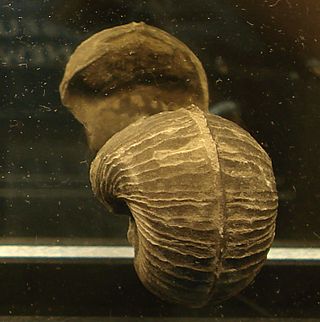
Bellerophon is a genus of extinct paleozoic marine molluscs of uncertain position in the family Bellerophontidae.

Calliostoma is a genus of small to medium-sized sea snails with gills and an operculum, marine gastropod molluscs within the family Calliostomatidae, the Calliostoma top snails. Previously this genus was placed within the family Trochidae. Calliostoma is the type genus of the family Calliostomatidae.

The gastropod shell is part of the body of a gastropod or snail, a kind of mollusc. The shell is an exoskeleton, which protects from predators, mechanical damage, and dehydration, but also serves for muscle attachment and calcium storage. Some gastropods appear shell-less (slugs) but may have a remnant within the mantle, or in some cases the shell is reduced such that the body cannot be retracted within it (semi-slug). Some snails also possess an operculum that seals the opening of the shell, known as the aperture, which provides further protection. The study of mollusc shells is known as conchology. The biological study of gastropods, and other molluscs in general, is malacology. Shell morphology terms vary by species group.

Stringocephalus is an extinct genus of large brachiopods; between 388.1 to 376.1 million years old they are usually found as fossils in Devonian marine rocks. Several forms of the genus are known; they may be found in western North America, northern Europe, Asia and the Canning Basin of Western Australia. Several different types are known; they share a well-developed, curved structure shaped like a beak. Some of the largest specimens discovered to date have been found in China.

Scenella is an extinct genus of fossil invertebrate animal which is generally considered to be a mollusc; at various times it has been suggested that this genus belongs with the gastropods, the monoplacophorans, or the helcionellids, although no firm association with any of these classes has been established. An affinity with the hydrozoa has been considered, although some authors oppose this hypothesis. A gastropod affinity is defended on the basis of six pairs of internal muscle scars, whilst the serially-repeated nature of these scars suggests to other authors a monoplacophoran affinity. However the specimens showing this scarring have not been convincingly shown to belong to the genus Scenella. A similarity to the Ediacaran Ovatoscutum has also been drawn.

Conus leopardus, common name the leopard cone, is a species of a predatory sea snail, a marine gastropod mollusk in the family Conidae, the cone snails, cone shells or cones.
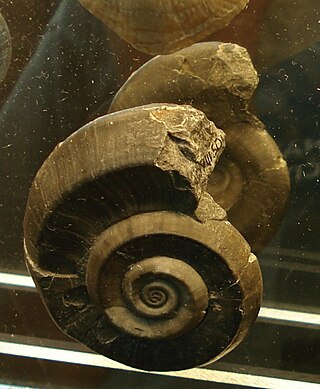
Euomphaloidea, originally Euomphalacea, is an extinct superfamily of marine molluscs that lived from the Early Ordovician to the Late Cretaceous, included in the Gastropoda but speculated as instead perhaps Monoplacophora.
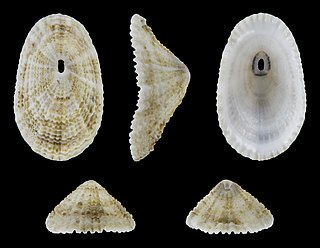
Diodora graeca, the Greek keyhole limpet, is a sea snail or limpet, a marine gastropod mollusk in the family Fissurellidae, the keyhole limpets.
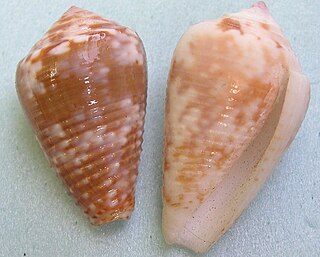
Conus catus, common name the cat cone, is a species of sea snail, a marine gastropod mollusk in the family Conidae, the cone snails and their allies.

Conus daucus, common name the carrot cone, is a species of sea snail, a marine gastropod mollusk in the family Conidae, the cone snails and their allies.

Bela nebula, also known as the nebular needle conch is a species of sea snail, a marine gastropod mollusk in the family Mangeliidae. It is the type species of the genus Bela.
Conorbis is an extinct genus of sea snails, marine gastropod mollusks in the family Conorbidae.
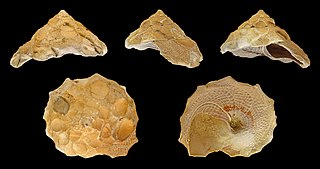
Xenophora crispa, the Mediterranean Carrier Shell, is a species of large sea snail, a marine gastropod mollusk in the family Xenophoridae, the carrier shells.

Cardioceras is an extinct ammonite genus belonging to the family Cardioceratidae. These fast-moving nektonic carnivores lived during the Jurassic period, Oxfordian age.

Velates is an extinct genus of marine gastropod mollusks belonging to the family Neritidae.
Calliomphalus is an extinct genus of sea snails in the family Eucyclidae.

Lirabuccinum dirum, commonly known as the dire whelk, the spindle shell or the spindle whelk, is a species of sea snail, a marine gastropod mollusk in the family Buccinidae, the true whelks. It used to be known as Searlesia dira and Buccinum dirum before being transferred to the genus Lirabuccinum.
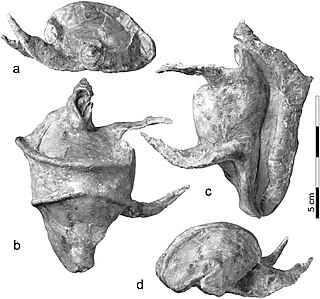
Vicetia is a genus of cowrie from the Eocene of Europe and Pakistan. Five species are currently recognized with all European forms forming a single anagenetic lineage progressively growing bigger and developing stronger ornamentation. The last known species, V. bizzottoi, is the biggest known cowrie known to science with a shell length of 33.5 cm. They were likely feeding on sponges or algae and went extinct following widespread climate change at the end of the Eocene, giving way for more derived lineages of cowries.


















